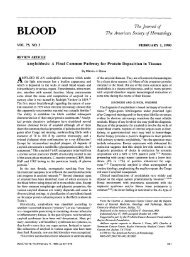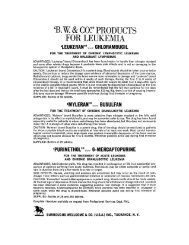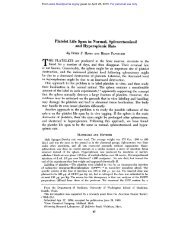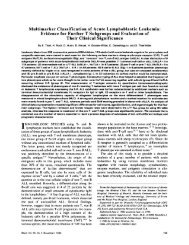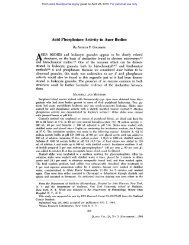View - Blood
View - Blood
View - Blood
Create successful ePaper yourself
Turn your PDF publications into a flip-book with our unique Google optimized e-Paper software.
Monoclonal Antibody T-Cell-Depleted HLA-Haploidentical Bone Marrow<br />
Transplantation for Wiskott-Aldrich Syndrome<br />
By Stephen L. Rumelhart, Michael E. Trigg, Sheldon D. Horowitz, and Richard Hong<br />
Four patients with Wiskott-Aldrich syndrome received<br />
bone marrow transplants (BMT) using monoclonal antibody<br />
T cell-depleted HLA-haploidentical marrow from a family<br />
member donor. The patients did not receive a significantly<br />
larger inoculum of mature T cells than other recipients of T<br />
cell-depleted marrow transplants. All four patients achieved<br />
quick engraftment, and three of the four patients are alive<br />
and well today. The three living patients have all had a<br />
complete return of normal T-cell and 6-cell function.<br />
Infectious complications in the surviving patients were<br />
minimal: however, all three experienced some degree of<br />
graft-versus-host disease (GVHD). Two of these three<br />
patients received GVHD prophylaxis. The patient not<br />
HE WISKOTT-ALDRICH syndrome (WAS) is an<br />
T X-linked recessive, primary immunodeficiency charac-<br />
terized by eczema, thrombocytopenia, recurrent infection,<br />
and increased susceptibility to lymphoreticular malignancies.<br />
Antibody production is deficient, particularly to polysaccharide<br />
antigens, and the serum immunoglobulin pattern is<br />
characterized by a low IgM and elevated IgA. Patients with<br />
this disorder usually succumb to overwhelming infections or<br />
severe hemorrhage before age 10 years.’<br />
A recent review reported that 80% (33/41) of WAS<br />
patients who received a bone marrow transplant (BMT)<br />
from a human leukocyte antigen (HLA)-identical donor<br />
survived, whereas of those whose donors were only haplomatched<br />
at HLA loci, survival was 23% (3/13).* In contrast,<br />
BMT from HLA-haplomatched donors correct other primary<br />
immunodeficiency disorders just as well as BMT from<br />
HLA-identical donor^.^.^ Therefore, Wiskott-Aldrich syndrome<br />
may represent a more difficult disease to correct with<br />
haplomatched donors.<br />
We describe our experience with four WAS patients who<br />
have been transplanted with HLA-haplomatched bone marrow<br />
depleted of mature T cells by treatment with monoclonal<br />
antibody (MoAb) CT-2 and complement. Good engraftment<br />
was attained in all, and three have survived from 300 to 900<br />
days. Analysis of these transplant experiences provides<br />
further insight into the consideration of haplomatched T-<br />
depleted bone marrow as treatment of WAS.<br />
Patients<br />
MATERIALS AND METHODS<br />
The clinical courses and major clinical features of the patients are<br />
shown in Table 1. The history of infectious diseases varied, but was<br />
most severe for patient 4. Patient 1 was transplanted relatively early<br />
in the course of his disease, whereas the remainder were transplanted<br />
at 5 to 10 years of age. All patients showed the small platelets and<br />
lack of isohemmagglutinins characteristic of WAS. Patient 1 was<br />
the first patient with WAS transplanted at The University of Iowa<br />
and patients 2, 3, and 4 are three consecutive patients with WAS<br />
who underwent BMT at the University of Wisconsin.<br />
Preparation and Patient Care<br />
All patients received cyclophosphamide (45 mg/kg body weight<br />
per day for two doses) and cytosine arabinoside (2 gm/m2 body<br />
receiving GVHD prophylaxis experienced severe GVHD and<br />
had a difficult posttransplant course. The patient who did<br />
not survive was chronically ill before BMT. whereas the<br />
other patients were in relatively good health at the time of<br />
BMT. Since the majority of individuals with this disease<br />
lack a matched bone marrow donor, our results using<br />
partially matched donors suggest that a greater number of<br />
patients can be successfully treated for Wiskott-Aldrich<br />
syndrome and that outcome is related to control of GVHD<br />
and state of health before BMT. Marrow transplantation<br />
should be offered earlier in the disease course before the<br />
onset of major infectious problems.<br />
0 1990 by The American Society of Hematology.<br />
surface area twice daily for 3 days). Patients 2, 3, and 4 received<br />
total body irradiation (TBI; 1,320 cGy total dose) given in eight<br />
equal fractions. Patient 1 was given busulfan 4 mg/kg for four daily<br />
doses in lieu of TBI because of the deleterious effects of TBI in young<br />
infants. Previous experience had shown that cytosine arabinoside<br />
added to the preparative regimen was necessary to obtain engraftment<br />
when using T cell-depleted haplomatched bone marrows for<br />
transplant?<br />
The children were nursed on bone marrow transplant units that<br />
used filtered air; however, laminar-flow rooms were not used.<br />
Hyperchlorinated water was used for patient 1. Antibiotics were<br />
given empirically with the onset of fever in excess of 38.5OC.<br />
Protocols for treatment of the children and collection of specimens<br />
for research purposes were approved by the respective Human<br />
Subject Committees at the University of Iowa and the University of<br />
Wisconsin.<br />
Marrow Preparation<br />
Bone marrow was obtained from the donors under regional or<br />
general anesthesia. The marrow was depleted of mature T lymphocytes<br />
by the addition of CT-2 (a mouse IgM anti-CD2 antibody) and<br />
rabbit serum as a source of complement.6 The marrow was given<br />
intravenously upon completion of the depletion process; the nucleated<br />
cell dosage is given in Table 1. Estimates of residual T cells were<br />
made as described by Martin and Hansen.’<br />
From the Division of Pediatric Bone Marrow Transplantation,<br />
Department of Pediatrics, University of Iowa, Iowa City, IA; and<br />
the Department of Pediatrics, University of Wisconsin, Madison,<br />
WI.<br />
Submitted May 24,1989: accepted October 25,1989.<br />
Supported in part by the Pediatric Cancer Research Fund of the<br />
University of Iowa.<br />
Address reprint requests to Michael E. Trigg, MD. Associate<br />
Professor of Pediatrics and Director of Pediatric Bone Marrow<br />
Transplantation, The University of Iowa Hospitals and Clinics,<br />
2524 John Colloton Pavilion. Iowa City, IA 52242.<br />
The publication costs of this article were defrayed in part by page<br />
charge payment. This article must therefore be hereby marked<br />
“advertisement” in accordance with 18 U.S.C. section 1734 solely to<br />
indicate this fact.<br />
0 1990 by The American Society of Hematology.<br />
0004-4971/90/7504-0015$3.00/0<br />
<strong>Blood</strong>, Vol 75, No 4 (February 15). 1990: pp 1031-1035 1031
1032 RUMELHART ET AL<br />
Table 1. Clinical Features and Clinical Courses<br />
Pt 1 Pt 2<br />
Pt 3<br />
Pt 4<br />
Age at diagnosis<br />
Age at BMT<br />
Average platelet<br />
count (x io3)<br />
Small platelets<br />
Major infections<br />
Donor<br />
Significant bleeding<br />
HLA typing (PtIDo)<br />
HLA-A<br />
HLA-8<br />
HLA-DR<br />
MLC reactivity (Pt/Do)*<br />
Pt x Do,<br />
Do x Pt,<br />
Conditioning regiment<br />
Nucleated cell dosage (/kg1<br />
No. T cells givenlkg body weight<br />
GVHDS<br />
Skin<br />
Liver<br />
GI<br />
Other<br />
Outcome<br />
5 wks 6 mos<br />
13 mos 5 Yrs<br />
30 20<br />
Y<br />
Recurrent diarrhea, infected<br />
eczema, otitis<br />
Father<br />
N<br />
Y<br />
Sinus<br />
Father<br />
N<br />
2.2612.26 3.2613.28<br />
8,1418 7.45/7,35<br />
3.7/3,7<br />
6801426 2991244<br />
6,6131727 26,36512,264<br />
BuICYlara<br />
CY/ara/TBI<br />
8.9 x lo8 2.3 x 10'<br />
~ ~<br />
MISMATCHED BMT FOR WISKOlT-ALDRICH SYNDROME 1033<br />
Days post-BMT*<br />
Platelet count ( x io3)<br />
Total lymphocytes<br />
T cells (CD3)t<br />
CD4 i<br />
CD8 i<br />
PHAS<br />
PWM<br />
conA<br />
SKSD<br />
Tet<br />
Cand<br />
B cellst<br />
B1<br />
04<br />
IgG (mg/dL)<br />
IgA (mg/dL)<br />
IgM (mg/dL)<br />
IgE (IUImL)<br />
Isoagglutinins§<br />
anti-A<br />
anti-B<br />
Natural Killer<br />
NKH-1<br />
Table 2. Laboratory Parameters<br />
Pt 1 Pt 2 Pt 3<br />
34 1<br />
33 1<br />
1,840<br />
41<br />
31<br />
8<br />
34<br />
27<br />
28<br />
0.7<br />
0.5<br />
47.0<br />
2<br />
2<br />
7061839<br />
158117<br />
61/61<br />
NDIND<br />
O/ND<br />
O/ND<br />
ND/3 1<br />
895<br />
599<br />
3,600<br />
36/70<br />
28/43<br />
10118<br />
5371993<br />
15011 7 1<br />
19015 1 1<br />
1.014.0<br />
2.011 .o<br />
1.0122.0<br />
1015<br />
NDl8<br />
2,960/807<br />
91/28<br />
34/52<br />
ND/28<br />
018<br />
010<br />
ND/7<br />
332<br />
27 1<br />
1,900<br />
4213 1<br />
37/29<br />
18/16<br />
13011 86<br />
14/43<br />
3319<br />
1.012.0<br />
2.018.0<br />
6.0/ 1 .O<br />
913<br />
NDl5<br />
6941655<br />
204198<br />
4911 17<br />
49/3<br />
010<br />
010<br />
ND114<br />
Abbreviations: Pt, patient; ND, not determined; PWM, pokeweed<br />
mitogen; conA, Concanavalin A; SKSD, streptokinase-streptodornase;<br />
tet, tetanus toxoid; cand, candida.<br />
‘Day on which last evaluation was performed.<br />
tFirst number in column is value pre-BMT; second number is last value<br />
determined. Lymphocyte number is given as percent.<br />
*Response to mitogen or antigen is a stimulation index (stimulated<br />
cpmlnonstimulated cpm). All mitogen responses are normal. Stimulation<br />
by antigen should be greater than 3.0.<br />
§Expressed as reciprocal of titer, except absent titers, which are<br />
expressed as 0 (pre-BMT).<br />
marrow at the University of Wisconsin. Steroid therapy was<br />
initiated at 2 mg/kg because of a worsening of the skin on<br />
day 24 posttransplant. At this time, there was slight elevation<br />
of serum gamma glutamyl transferase (GGT) to 172 1U. He<br />
showed gradual worsening of his GVHD despite steroids, and<br />
approximately 6 weeks posttransplant, his pulmonary status<br />
acutely worsened with the picture of adult respiratory<br />
distress syndrome. He required intubation. High dose intravenous<br />
pulses of methylprednisolone (1 gm) were given and<br />
azathioprine was started. His eyes stopped tearing and<br />
corneal ulcers developed. Local prednisone ophthalmic ointment<br />
was added to the treatment regimen.<br />
He gradually improved and ventilatory support was<br />
stopped. His liver remained involved (maximal values: GGT<br />
4359, aspartyl aminotransferase (AST) 554, and bilirubin<br />
8). Approximately 14 weeks after transplant, cyclosporine<br />
was added to the regimen. His skin by now was atrophic with<br />
a prominent livedo reticularis pattern. He was discharged<br />
119 days after transplant. At that time he had chronic<br />
GVHD with skin and liver involvement and a prominent<br />
sicca syndrome requiring artificial tears. He received cyclosporin,<br />
azathioprine, and prednisone for 12 months with<br />
return of his liver enzymes to normal and marked improvement<br />
in his skin. When last seen in September, 1988, two<br />
years after the transplant, his skin was normal and there were<br />
no contractures.<br />
Clinical course of patient 4. Patient 4 had a stormy<br />
posttransplant course and died 37 days after transplant.<br />
Before the transplant, he had experienced repeated bouts of<br />
severe Herpes simplex infections and pneumonia. Early in<br />
the transplant course, he showed evidence of liver disease.<br />
Ten days after the transplant, his creatinine rose to 1.2<br />
(baseline 0.6) and intravenous cyclosporine (5 mg/kg continuous<br />
infusion) was stopped. His renal failure progressively<br />
worsened and hemodialysis was required. He responded, and<br />
over a period of 1 week, his creatinine gradually returned to<br />
baseline levels. During this interval his serum bilirubin<br />
slowly increased and on the ninth posttransplant day was 2.2.<br />
At that time, his alkaline phosphatase was 168, GGT 185,<br />
and AST 255. From this time until his death, his bilirubin<br />
continued to rise and was disproportionately elevated compared<br />
with GGT and AST levels. Terminally, the total<br />
bilirubin was 29.0 (direct reading 19.7), alkaline phosphatase<br />
1127, GGT 554, and AST 144.<br />
He showed definite neutrophil engraftment on day 15<br />
post-BMT (1,400 total leukocyte count), and this level was<br />
sustained until his death. Skin GVHD appeared coincident<br />
with neutrophil engraftment and consisted of a generalized<br />
maculopapular eruption without bullae formation.<br />
He developed severe hemorrhagic gastroenteritis; a colon<br />
biopsy showed only atrophic mucosa without evidence of<br />
GVHD or cytomegalovirus infection. However, Herpes simplex<br />
type I was cultured from the biopsy and adenovirus from<br />
Table 3. Tempo of Engraftment<br />
Pt 1 Pt 2 Pt 3<br />
Neutrophils >500<br />
for 3 consecutive days 15 15 16<br />
Last day of platelet transfusion 17 9 12<br />
Total lymphocytes >750 24 355-393 120-180<br />
CD3f > 675/pL 152 355-393 120-180<br />
CD4i > 45014 152 355-393 120-180<br />
CD8f > 225/pL 152 668-895 120-180<br />
B1+ > 75/pL 341 393-411 120-180<br />
Specific antibody<br />
IgA anti-E Coli ND >895* NAt<br />
IgM anti-€ Coli ND 807 NA<br />
IgA anti-tetanus ND NA NA<br />
IgM anti-tetanus ND 510 NA<br />
IgA anti-diphtheria ND >E95 NA<br />
IgM anti-diphtheria ND 510 NA<br />
Tempo reported as number of days after BMT for values to attain<br />
criterion shown in leftmost column; where a range is shown, the value<br />
was attained during that interval between examinations.<br />
Abbreviations: Pt, patient; ND, not determined MA, not applicable.<br />
’”>” means that value was greater than value as of last day of<br />
examination shown in column.<br />
tThe value did not decrease appreciably after conditioning, remaining<br />
within normal limits. Note patient 1 was never immunized pre-BMT.<br />
Values at 18 months post-BMT were indicative of nonimmunity, and the<br />
child was scheduled to undergo a primary series of immunizations.
1034 RUMELHART ET AL<br />
his stool at this time. His condition progressively deteriorated,<br />
and he died of overwhelming staphylococcal sepsis 37<br />
days after the transplant.<br />
Patient 4 had moderate skin GVHD. Other severe systemic<br />
disease involving the liver and kidneys, followed by<br />
fatal sepsis, make the full extent of GVHD involvement<br />
(other than the moderate skin GVHD) difficult to assess in<br />
his case.<br />
DISCUSSION<br />
Bone marrow transplantation has proven to be an effective<br />
treatment for Wiskott-Aldrich syndrome and other immunodeficiencies<br />
when a matched sibling donor is a ~ailable.~‘~~~~~~~<br />
The problems of thrombocytopenia, eczema, and recurrent<br />
infections have been eliminated after successful engraftment<br />
has been established. However, more extended evaluation is<br />
needed to determine whether successful engraftment also<br />
eliminates the risk for lymphoreticular malignancies characteristic<br />
of the disease. Due to the many complications<br />
associated with this disease, a bone marrow transplant should<br />
be done early in the disease course whenever possible, or at<br />
least before the onset of major infectious complications. In<br />
our experience with other forms of primary immunodeficiency,<br />
delay has resulted in the acquisition of a complicating<br />
infection that greatly increases the morbidity after transplant<br />
and usually results in an unsuccessful outcome! We<br />
believe that our experience with WAS is also consistent with<br />
this view.<br />
In the three children who were in relatively good health at<br />
the time of transplant, the engraftment was rapid and<br />
durable in two. Patient 2, who did not receive GVHD<br />
prophylaxis, experienced chronic GVHD and therefore, a<br />
lengthy recovery. We believe that had GVHD prophylaxis<br />
been instituted, he too would have had a more benign course<br />
and rapid recovery. Patient 4, however, who had a long<br />
history of severe chronic infections and was in poor health at<br />
the time of transplant, had a stormy posttransplant course<br />
and died. He may have suffered from hyperacute GVHD.<br />
If possible, an HLA-matched bone marrow donor is used;<br />
however, the majority of individuals will lack an HLAidentical<br />
donor. In this situation a partially matched family<br />
member or closely matched unrelated individual can be used<br />
as the donor, and the marrow is depleted of T lymphocytes to<br />
prevent or diminish the severity of GVHD.16<br />
Our results reveal that successful engraftment can be<br />
achieved in patients suffering from Wiskott-Aldrich syndrome<br />
who do not have an HLA-identical, mixed lymphocyte<br />
culture nonreactive sibling donor. This has been accomplished<br />
with an ablative regimen consisting of TBI (or<br />
busulfan), cytosine arabinoside, and cyclophosphamide early<br />
in the disease course, followed by the administration of T<br />
lymphocyte-depleted bone marrow.s,8.16 B-cell and T-cell<br />
reconstitution were achieved within 12 months after transplant<br />
in two patients and have been ultimately attained in the<br />
third, after achieving control of chronic GVHD. Except for<br />
patient 4, infectious complications were minimal.<br />
These data suggest that results comparable with those of<br />
Wiskott-Aldrich patients transplanted with HLA-identical<br />
donor marrow might be attained; however, one must be<br />
particularly watchful for complications of graft-versus-host<br />
disease. We believe prophylaxis is mandatory, contrary to<br />
the usual practice for combined immune deficiency disease.<br />
2.4.10-1 s<br />
In contrast to recipients of matched non-Tdepleted<br />
marrow, WAS patients will also require more<br />
pretransplant conditioning (cytosine arabinoside) and may<br />
require more posttransplant immunosuppression for GVHD<br />
control. Although the long term impact on the child of these<br />
additional therapies remains to be determined, three of four<br />
children described in this report are alive and well, having<br />
previously had a disease for which there was no other<br />
treatment yet available with a curative intent. Furthermore,<br />
early transplant in growing children may prevent delayed<br />
growth and development secondary to chronic eczema, recurrent<br />
overwhelming infections, and lymphadenopathy.<br />
The reason for the severity of GVHD in WAS is unclear.<br />
We have examined the degree of T-cell contamination for the<br />
last 21 consecutive T cell-depleted haploidentical BMT<br />
performed at the University of Wisconsin, using the method<br />
described by Martin and Hansen.’ The degree of depletion<br />
by our protocol is of the order of 1.5 to 2 logs. After depletion,<br />
the frequency of phytohemagglutinin (PHA)-responsive T<br />
cells in the bone marrow inoculum averages 1/51 to 50,000,<br />
and no patient has received more than 1.6 x 10’ mature T<br />
cells per kilogram body weight. Kernan et all7 suggest that<br />
lo5 clonable T cells per kilogram body weight will produce<br />
GVHD. Patients 2, 3, and 4, for whom measurements are<br />
available, received 5 x lo4, 1.2 x lo4, and 1.2 x los,<br />
responding T cells per kilogram body weight. One cannot<br />
directly equate the number of PHA-responsive cells as<br />
determined by us to the clonable T cell number described by<br />
Kernan et al,” but the severity of GVHD seen in other<br />
primary immunodeficiency patients previously transplanted<br />
here suggests that our numbers are of the same order of<br />
magnitude as those in their studies. In any event, the WAS<br />
patients did not receive a significantly larger inoculum of<br />
mature T cells than other recipients of T cell-depleted BMT.<br />
We believe that the severity of GVHD is in part determined<br />
by the degree of immunity originally present in the<br />
host, and for this reason, patients with hematologic malignancy<br />
or aplastic anemia have traditionally required GVHD<br />
prophylaxis even with matched BMT, whereas those with<br />
primary immunodeficiency do not. Other factors, such as<br />
leukemia antigen and infection are also factors involved in<br />
the severity of the clinical picture.18 When the marrow is<br />
exhaustively depleted of mature T cells (3 or more log<br />
depletion), GVHD is essentially nil, but poor engraftment<br />
and leukemia recurrence are major problem^."*'^.^^ We have,<br />
therefore, used a less rigorous depletion protocol. In all cases<br />
of primary immunodeficiency other than Wiskott-Aldrich<br />
syndrome, this strategy has worked well without GVHD<br />
prophylaxis!<br />
Although all marrows were T cell-depleted, successful<br />
engraftment was not a problem, as has been previously<br />
recorded.8.” This confirms our experience with this conditioning<br />
regimen, which is used in the preparation of patients with<br />
hematologic malignancy as well as immunodeficien~y.~*~.’~<br />
On the basis of these results, we believe that Wiskott-<br />
Aldrich syndrome can be effectively treated with haploiden-
MISMATCHED BMT FOR WISKOTFALDRICH SYNDROME 1035<br />
cal T cell-depleted bone marrow transplants. Our data<br />
indicate that outcome is related to the control of graft-versushost<br />
disease and the Overall state Of health before the<br />
transplant, and Our results argue for earlier, rather than<br />
later, bone marrow transplantation therapy even in the<br />
absence of an HLA-identical donor.<br />
ACKNOWLEDGMENT<br />
We thank Joan Smith for manuscript preparation, Tom Riley for<br />
preparation of tables and graphics for this report, and the dedicated<br />
nursing staffs at The University of Iowa and The University of<br />
Wisconsin, who provide care to the children undergoing marrow<br />
transplantation.<br />
1. Ammann AJ, Hong R Disorders of the T-cell system, in<br />
Immunologic Disorders of Infants and Children. Philadelphia, PA,<br />
WB Saunders, 1989, p 276<br />
2. Buckley RH: Advances in the correction of immunodeficiency<br />
by bone marrow transplantation. Pediatr Ann 16:412, 1987<br />
3. OReilly RJ, Brochstein J, Collins N, Keever C, Kapoor N,<br />
Kirkpatrick D, Kernan N, Dupont B, Burns J, Reisner Y: Evaluation<br />
of HLA-haplotype disparate parental marrow grafts depleted of T<br />
lymphocytes by differential agglutination with a soybean lectin and<br />
E-rosette depletion for the treatment of severe combined immunodeficiency.<br />
VoxSang 51:81,1986 (suppl)<br />
4. Moen RC, Horowitz SD, Sondel PM, Borcherding WR, Trigg<br />
ME, Billing R, Hong R Immunologic reconstitution after haploidentical<br />
bone marrow transplantation for immune deficiency disorders:<br />
Treatment of bone marrow cells with monoclonal antibody CT-2 and<br />
complement. <strong>Blood</strong> 70:664,1987<br />
5. Bozdech M, Sondel PM, Trigg ME, Longo W, Kohler PC,<br />
Flynn B, Billing R, Anderson SA, Hank J, Hong R: Transplantation<br />
of HLA-haploidentical T-cell depleted marrow for leukemia: Addition<br />
of cytosine arabinoside to the pretransplant conditioning prevents<br />
rejection. Exp Hematol 13:1201, 1985<br />
6. Trigg ME, Peterson A, Erickson C, Bozdech MJ, Billing R,<br />
Sondel PM, Finlay JL, Surfus J, Stuiber M, Hong R: Depletion of<br />
T-cells from bone marrow for allogeneic transplantation: Method for<br />
treatment of bone marrow in bulk. Exp Hematol 14:21, 1986<br />
7. Martin PJ, Hansen JA: Quantitative assays for detection of<br />
residual T-cells of T-depleted human marrow. <strong>Blood</strong> 65:1134, 1985<br />
8. Trigg ME, Gingrich R, Goeken N, de Alarcon P, Klugman M,<br />
Padley D, Rumelhart S, Giller R, Wen B-Chen, Strauss R: Low<br />
rejection rate when using unrelated or haploidentical donors for<br />
children with leukemia undergoing marrow transplantation. Bone<br />
Marrow Transplantation 4:43 1, 1989<br />
9. Glucksberg H, Storb R, Fefer A, Buckner CD, Nieman PE,<br />
Clift RA, Lerner KG, Thomas ED: Clinical manifestations of graftversus-host<br />
disease in human recipients of marrow from HLA<br />
matched sibling donors. Transplantation 1~295, 1974<br />
10. Parkman R, Rappaport D, Geha R, Cassady R, Levey R,<br />
Nathan DG, Belli J, Rosen F Complete correction of the Wiskott-<br />
Aldrich syndrome by allogeneic marrow transplantation. N Engl J<br />
Med 298:921,1978<br />
11. OReilly RJ, Brochstein J, Dinsmore R, Kirkpatrick E:<br />
REFERENCES<br />
Marrow transplantation for congenital disorders. Sem Hematol<br />
21:188, 1984<br />
12. Kapoor N, Kirkpatrick D, Blaese RM, Oleske J, Hilgartner<br />
MH, Chaganti RSK, Good RA, OReilly RJ: Reconstitution of<br />
normal megakaryocytopoiesis and immunologic functions in Wiskott-<br />
Aldrich syndrome by marrow transplantation following myeloablation<br />
and immunosuppression with busulfan and cyclophosphamide.<br />
<strong>Blood</strong> 57:692,198 1<br />
13. Goldsobel AB, Ehrlich RM, Mendoza GR, Stiehm ER: Bone<br />
marrow transplantation for Wiskott-Aldrich syndrome: Report of 2<br />
cases with use of 2-mercaptoethane sulfonate. Transplantation<br />
39568, 1985<br />
14. Fischer A, Friedrich W, Levinsky R, Vossen J, Griscetli C,<br />
Kubanek B, Morgan G, Wagemaker G: Bone marrow transplantation<br />
for immunodeficiencies and osteopetrosis: European survey,<br />
1968-1985. Lancet 21080, 1986<br />
15. Good RA: Bone Marrow Transplantation Symposium: Bone<br />
marrow transplantation for immunodeficiency diseases. Am J Med<br />
Sci 294:68, 1987<br />
16. Trigg ME, Billing R, Sondel PM, Finlay JL, Peterson A,<br />
Hong R, Frierdich S, Shahidi N: Mismatched bone marrow transplantation<br />
in children with hematologic malignancy using T-<br />
lymphocyte depleted bone marrow. J Biol Response Mod 4:602,<br />
1985<br />
17. Kernan NA, Collins NH, Juliano L, Cartagena T, Dupont B,<br />
OReilly RJ Clonable T lymphocytes in T cell-depleted bone<br />
marrow transplants correlate with development of graft-v-host<br />
disease. <strong>Blood</strong> 68:770, 1986<br />
18. Gale RP, Bortin MM, van Bekkum DW, Biggs JC, Dicke<br />
KA, Gluckman E, Good RA, Hoffmann RG, Kay HEM, Kersey JH,<br />
Marmont A, Masaoka T, Rimm AA, Van Rood JJ, Zwaan FE: Risk<br />
factors for acute graft-vs-host disease. Br J Haematol67:397, 1987<br />
19. Mitsuyasu RT, Champlin RE, Gale RP, Ho WG, Lenarsky<br />
C, Winston D, Selch M, Elashoff R, Giorgi JV, Well J, Terasaki P,<br />
Billing R, Fieg S: Treatment of donor bone marrow with monoclonal<br />
anti-T cell antibody and complement for the prevention of graftversus-host<br />
disease: A prospective, randomized, double-blind trial.<br />
Ann Intern Med 105:20, 1986<br />
20. Pollard CM, Powles RL, Miller JL, et al: Leukaemic relapse<br />
following Campath 1 treated bone marrow transplantation for<br />
leukaemia. Lancet 2:1343, 1986



